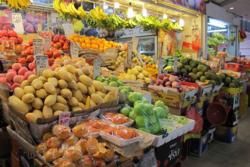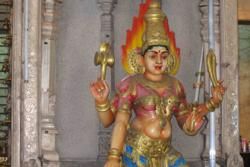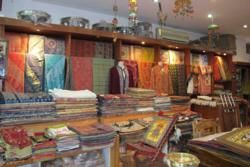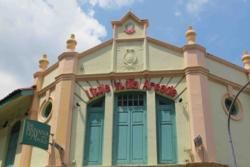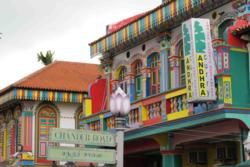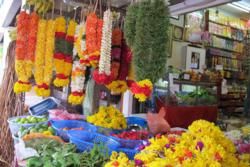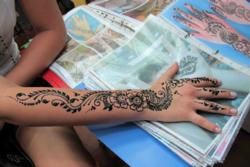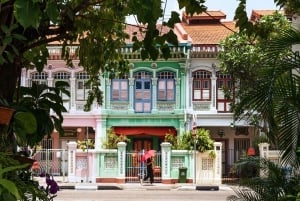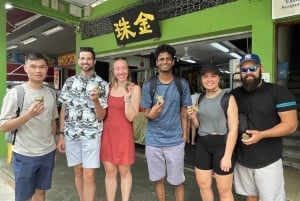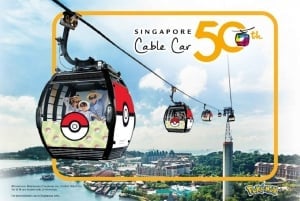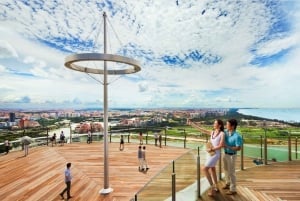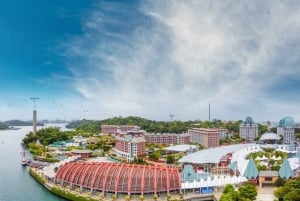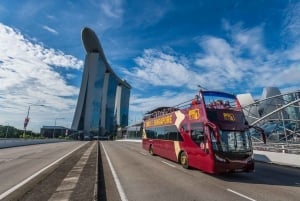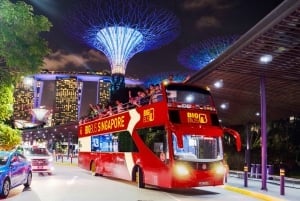Little India
One of Singapore’s fascinating cultural enclaves, Little India is home to the city’s third-largest ethnic community. Little India’s streets teem with activity, and the sights, sounds, smells and textures of Indian culture are everywhere. This is truly one of the most colourful neighbourhoods in Singapore, especially during traditional festivals such as Deepavali – the start of the Hindu New Year. Busy shops offer brilliant-hued saris and shoes to match, a treasure trove of golden jewellery, fragrant spices, all sorts of distinctively Indian decorations, incense and the like. All the while, the latest Bollywood hits play in nearby cinemas. Most visitors prefer to discover Little India by foot, to best appreciate all its action and atmosphere.
An excellent starting point for a visit is the Tekka Centre, located at the intersection of Bukit Timah and Serangoon Roads. Tekka Centre features one of the largest wet markets in the city, as well as a food court and a complete shopping mall – all under one roof. The Tekka market was modernized a few years ago, and is now a neatly structured arrangement of stalls selling fish, meat, vegetables, fruits and spices. The combination of the markets many different aromas can be daunting, but a visit is nonetheless an unforgettable experience. Saturdays are especially busy here, since local residents head to market to buy fresh seafood, produce, and colourful garlands for the weekend ahead. Take time to explore, and be sure to sample some exotic fruits and other delicacies. The mall on the centre’s upper floors offers a splendid array of shops, many specializing in Indian goods of various types and kinds.
Following Bukit Timah Road south-eastward, you’ll soon come to another major shopping destination: Sim Lim Square, one of Singapore’s largest electronic and IT malls. Packed with stores specializing in consumer electronics and services, it’s well worth a visit. Be advised, though – it’s a very good idea to decide in advance what you’re going to for, and learn the regular retail price for each item. This way, you’ll be able to negotiate, bargain and secure the best possible price. One tip for Sim Lim visitors: the general rule is, the higher the floor, the lower the prices you can expect to find.
Opposite Tekka Centre you’ll encounter the Little India Arcade, selling Indian clothing and fabrics, spices, jewellery, handbags, handicrafts and so on. Here you can have your hands and feet decorated with henna, a dark red plant paste originally used only for special celebrations such as weddings or religious festivals. During Deepavali, the Hindu festival of light, Serangoon Road is gorgeously lit and decorated, with a large open-air market springing up for the occasion. Deepavali takes place each year in October or November, and is a general public holiday. As with Thaipusam in January or February, the exact date is set by the lunar calendar, and varies from year to year. During either of these festivals, you can expect enormous and sometimes boisterous crowds.
Further north along Serangoon Road you’ll find a smaller side street, Kerbau Road. This area has been dubbed the Little India Arts Belt. Its beautiful green lane is lined with shop houses which the government helped transform to house Singapore’s most outstanding companies of performing artists.
Continue along Serangoon Road – which is truly Little India’s centre – and you are greeted by the Sri Veeramakaliamman Temple. The oldest Hindu temple in Singapore, it is dedicated to the goddess Kali, and her images adorn its walls. Before entering, please be sure to remove your shoes, out of respect for custom and tradition. Each year, shortly before Deepavali, Little India celebrates the fire-walking festival of Timiti. On festival day, a procession begins at the temple and travels all the way to Chinatown – where festival participants walk on burning coals.
It’s well worth exploring the shops and small restaurants along Serangoon Road. Most Indian eateries serve curry on banana leaves, accompanied by rice and delicious naan bread. A complete and savoury meal costs only a few dollars, and includes fresh lime juice or freshly-brewed iced tea.
Towards the end of Serangoon Road, you’ll arrive at another of Little India’s highlights: Mustafa Centre. Located on Syed Alwi Road, it is a discount department store with a unique and almost chaotic flair. There is nothing comparable to found in all of Singapore. Mustafa Centre, which is open 24 hrs, sells everything and anything – all kinds of kitchen wares and decorations, fancy Indian-style shoes and apparel, electronics, airline tickets, bags of spices, mountains of fresh mangos, and of course, jewellery and watches. There is almost nothing that you could not find in this mall’s several storeys, and prices are extremely competitive.
If you still have some energy after visiting Mustafa Centre, head farther up Serangoon Road and visit the beautiful Sri Srinivasa Perumal Temple. One of the oldest temples in Singapore, its soaring entrance tower features depictions of the incarnations of Lord Vishnu. The temple itself is dedicated to Perumal, another name for Krishna; statues of him, all in blue, dominate the temple. It is also from this temple that the annual Thaipusam Procession begins.
As with any ethnic enclave, there are a few do’s and don’ts that you should bear in mind, while visiting. We’ve listed them for you here, along with a few general tips and tidbits we hope will help you enjoy your visit to Little India:
- Singapore is home to about half a million foreign workers, and the vast majority of them are natives of India. Sunday is their usual day off, and many enjoy relaxing in and around Little India during Sunday afternoons and evenings. Of course the majority of them are quite friendly, but confrontations have been known to occur now and then, among workers. There is no direct threat to visitors, but it’s good to be alert, to avoid any unintended unpleasantness. This sort of thing is practically unheard of at other times.
- On Mondays, wet markets are usually closed – so on this day you may find Little India a bit less lively and vibrant as at other times.
- Getting a taxi in Little India can be a challenge, especially on weekends. We suggest taking the MRT or bus, or booking a taxi by phone.
- Thaipusam, a major Hindu Festival that takes place in February, may prove upsetting to some visitors, particularly small children. As part of the festival, some male devotees pierce their half-naked bodies in various places (such as upper torso, cheeks or tongue) and attach iron hooks, to carry or pull heavy kavadis (baskets for ritual gifts). We’ve prepared a special article and video presentation, if you would like to learn more about Thaipusam.
We hope you’ll enjoy the exotic world of Little India; if you are open to its many sights, sounds, tastes and smells, you’re sure to return home with many fascinating experiences to share.
Watch this video of Little India and its various facets
Watch this video of Thaipusam


